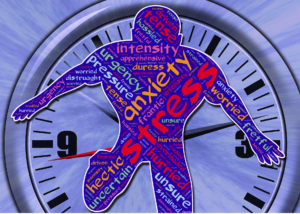There’s usually something that makes us anxious that adds to daily or ongoing anxiety. No matter how strong your confidence in certain arenas, there may be other areas that totally freak you out. While I can feel at ease in the midst of a medical crisis, I completely panic when swimming in deep water — even if I can see the bottom. That anxiety began after I saw the movie “Jaws.” I’m serious.

Credit: beauQ/pixabay
Anxiety & Its Role In Our Lives
But, fear can also play a very useful role in our lives. Anxiety can help teach us to focus and meet a deadline. It can also motivate us to prioritize going to the doctor to get checked out. That’s a healthy relationship with anxiety.
However, when anxious thought patterns and anxiety become the norm, it can bring on everything from mild physical discomfort to heart palpitations, shortness of breath, and even the dizziness of a full-blown panic attack. I’ve worked through bouts of unhealthy anxiety with myself, my family and hundreds of patients, to help resolve their physical symptoms through means of self-expression.
If you suffer from any form of anxiety, here are five quick, yet powerful steps to help you break free from this stressful pattern that can add to your anxiety:
Get Present
When you notice you’re having worrisome thoughts about the future (Hint: Those thoughts usually start with “what if …”), a quick way to interrupt that pattern is to focus on your body.
First, identify the unique physical signals your body is sending you (tense muscles, throat constriction, heart racing, trembling hands, etc.). Then pause by taking a few slow, deep breaths (relax your abdomen and become aware of the expansion and contraction of your ribcage).
Next, focus on the present moment (become aware of where you’re sitting or standing, and what physical sensations you’re feeling, etc.) and only what is occurring right now.
It might sound simple, but when you’re present in your body, you’re focused on the here-and-now. That way, you can’t be trapped in an endless loop of anxiety about the future.
Name That Fear
The monster under your bed loses its power when you turn on the light and all you find is an extended family of dust bunnies. Begin by naming your fears about the person, place, or situation you’re confronting. Then write down the phrase: “What I’m afraid of is … ” and finish the sentence as many times as you need to. Keep writing until there are no new thoughts.
Expand Your Perspective
You’re a pro at future-thinking. There’s one small problem: you can’t control the future. So just as your did with your body, it’s time to get your thoughts back into the present moment.
Go back to your list of fears and after each one, write the following statement: “Right here, right now, what I know for sure is that … ” Then end each statement with the facts you know about the present moment — not the what-if scenarios that are running in your head.
(Reminder: Facts are information you observe outside your body through your five senses — what you hear, see, taste, touch or smell. Facts also include the physical signals you’re receiving from inside your body.)
Reprogram Your Thinking

Credit: johnhain/pixabay
Can you believe how long it takes just to get into the present moment? But now that you’ve arrived, you can access the creative part of your brain to build new patterns of thinking.
I suggest creating affirmations —“I am” statements, followed by what you value — that replace fearful thoughts.
This will rewire your brain to engage in expanded thinking whenever future-thinking anxiety strikes.
When I worked with a woman whose dear friend was sick, her repetitive thought pattern went like this: What if I get sick too? What if I can’t do the things I love? To help her create an affirmation, I asked her what she valued most and what was true today. She came up with: “I am whole, healthy and well.”
Trust Yourself
Ask yourself one simple question: What would self-trust and courage do now? Listen to the answer and allow it to guide you. (And in case you were wondering, there are no wrong answers.)
If you want to change your relationship to anxiety, allow it to move through you and use it as an opportunity to get present in your body —how about trying right now? The more courageous you are about facing your fears head-on, the more self-trust you’ll build in the long run.
Welcome back from the future.
Other Useful Articles:
- Connecting to Spirit Medicine is Connecting to Ourselves
- 5 Things to Boost Your Mood When Flying
- Listening to Your Inner Voice
- Improve Your Resilience & Capacity to Love
- The Value of Community: Disconnect to Connect
______
Note: this article previously appeared on MBG/MindBodyGreen.com.
Neha Sangwan, M.D., CEO of Intuitive Intelligence is an Internal Medicine physician and communication expert combines the science of medicine with the art of communication to empower power people to strengthen their relationships, decrease their stress levels and improve their health. Doctor Neha is also the author of the Hay House book TalkRx: Five Steps to Honest Conversations that Create Connection, Health and Happiness. To learn more, go to doctorneha.com and follow her on Twitter @drnehasangwan.








